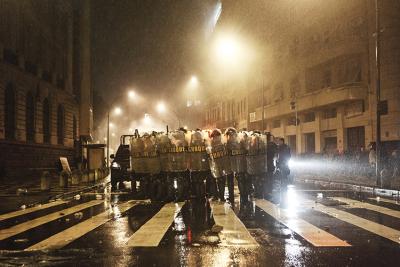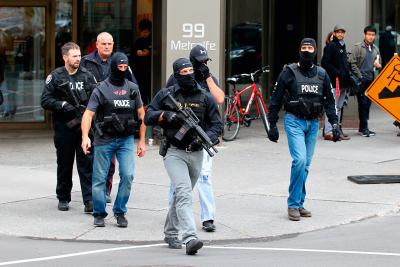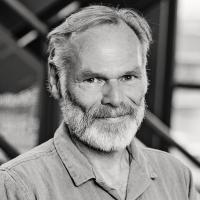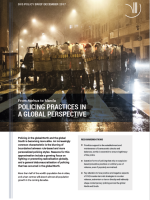Policing Practices in a Global Perspective

■ Question forms of policing that rely on suspicionbased
preventive practices or arbitrary use of violence, even if popularly normalised.
■ Pay attention to how positive and negative aspects of CVE/counter-terrorist strategies to counter violence, extremism or terror directly and indirectly
shape contemporary policing across the global North and South.
Policing in the global North and the globalSouth is becoming more alike. An increasinglycommon characteristic is the blurring ofboundaries between rule-based and morepersonalized policing styles. Reasons for thisapproximation include a growing focus onfighting or preventing radicalisation globally,and a general debureaucratisation of policingthat has occurred in the global North.
More than half of the world’s population live in cities,
and urban centres will absorb almost all population
growth in the coming decades.The growing size and density of cities combined with increasing inequality between their inhabitants, means that urban areas have become sites of intensified insecurity and violence. This occurs in a context where a multitude of actors makes claims to policing urban violence. While the mandate of the police is to enforce the law, police work in practice often extends beyond the official mandate of state-sanctioned law enforcement and crime regulation, breaking down clear-cut divisions between public and private. Policing in the global South and North is usually characterized as vastly different by researchers and policy-makers alike. However, by exploring how the state police make order in urban settings around the world, global commonalities emerge, including the blurring of boundaries between bureaucratic and more
intuitive policing styles.
Policing across the North-South divide
Policing in the global South is commonly seen as taking place in a context of limited statehood. In turn, this means that a multitude of actors – such asgangs, ex-combatants and private security firms –engages in and makes claims to policing the city in theabsence of the state police. This emphasis tends toput the role of the state police in the background andmeans that the global South is approached assomewhat unique, even exotic, when it comes to therole of so-called non-state actors.
Yet, contemporary policing practices in the global South are not necessarily substantially different from those in the North. One of the reasons for this is that policing of complex urban security threats in the North associated with radicalization and terrorism have given rise to an expansion of policing beyond securityrelated aspects of law enforcement.
Covert policing and security as social welfare
A major shift in policing practices, which hascontributed to greater resemblance on a global cale,
began in the early 2000s in the context of the “War onTerror”. Across the world, countering violence andextremism has gradually legitimized more covertpolicing practices that push and sometimes cross theboundary of what is within the rule of law. In Nairobi,for instance, where terrorist attacks are linked to Somali refugees, policing has translated into arbitraryarrests, and practices that disregard national andinternational law.
Policing in many parts of the world is often accompanied by
considerable fear among the police and policed alike.
In Europe, the agenda to counter violence and extremism has legitimized the extension of policing
practices into new sectors of the welfare system, andthereby blurred boundaries between security and otherpublic services. The ‘Aarhus Model’ in Denmark wasestablished as a counter-radicalization initiative that isrun by a variety of social services, including the youthsector, unemployment centre, street-based workers,social-psychiatric services – and the police.
The partial dissolution of what constitutes a particularpolicing task is reinforced further by the way in whichradicalization is depicted. The ‘Aarhus Model’ uses theWorld Health Organization’s model for how epidemicsspread to explain the dangers of radicalisation. WhileDanish authorities do not see the relationship betweenradicalization and a virus as one-to-one, they seeradicalization as something that spreads, and whilesome are more at risk than others are, everyone canbe ‘infected’.
Proximity and plural policing
An emerging commonality between policing in theglobal South and North is the blurring of boundariesbetween bureaucratic, rule-based and morepersonalized and intuitive policing styles. When states are considered fragile or failing, a centralcharacteristic is a weak bureaucratic system thatlacks administrative and political checks andbalances. Fragility and failure are labels that areapplied to a number of states in the global South. Atthe same time, the perception that bureaucratisation– or too much of it – is negative and even, anti-liberal,influences the evolution of policing practices in theglobal North.

Police reform in the Netherlands, for instance, hasover the past years sought to minimize the distancebetween the public and the police by debureaucratisingpolicing practices. This involves minimizingthe paperwork and administration that is part ofworking within state institutions, but creates distancebetween police and population. The rationale behinddebureaucratisation is that police officers should be inthe streets, not behind desks.
This has led to a move from ‘state externality’ to ‘stateproximity’, which blurs the boundary betweenprofessional and private identities of police officers.These processes of blurring have facilitated a shiftfrom criminal to popular justice, including racialprofiling, which is increasingly central to policingpractices across both the global South and North.
The move from rule-based to more intuitive policingstyles has also facilitated the appropriation of militarytechniques. This ranges from the employment ofmilitary equipment in the fight against urban crime toan array of propaganda methods to ‘win the heartsand minds’ of the population.
Debureaucratisation in the global North may havediminished the distance between the police and thepoliced, and made the demarcation of competenciesbetween state institutions progressively blurred.However, in several countries, primarily across theglobal South, the extension of policing beyondstate-sanctioned law enforcement has neverdiminished, because bureaucratic practices alwaysplayed a limited role in this regard. In Maputo, forinstance, the police in many cases work throughconstant negotiation of legality and popularlegitimacy. What is at stake is the status of the police,indeed, the definition of what the state should andshould not do.
Violence against the police and police violence
Police violence is rarely applied without a degree of acceptance from a cross-section of the population thatfears crime, terrorism or both. However, the police is notonly the perpetrator, but also a victim of violence.
In Dhaka, Bangladesh, kneecapping is usedmethodically to punish suspects, and in Rio de Janeiropoliticians and the police depict policing as warfare incertain parts of the city. Policing in these contexts isoften accompanied by considerable risk for localcommunities, but also for the officers themselves. InRio, officers perceive their routines inside and outsidetheir job as unsafe. They risk assassinations, forinstance, during armed assaults when they respond toa robbery or if the perpetrators realise that they arerobbing a member of the police. At times, they are
victims of targeted attacks.
As the police seek to maintain and enforce urbanorder, different rules and practices often apply to
different socio-economic and ethnic groups. Indeed, amoral boundary may be drawn between those who areallowed to live and those who are not. In poor urbansettlements, in Nairobi for instance, policing strategiesare built up around the explicit use of violence. The
target of extra-judicial killings is commonly young mensuspected of being thieves, (potential) terrorists orboth.
Policing is a form of social control that includes
processes of surveillance and the threat or use of
physical punishment to make and sustain order.
Violent forms of policing are also prominent in thePhilippine government’s War on Drugs. In Manila, thepolice portray themselves as working inside the law,yet act outside it. This form of policing has created aclimate of fear that is used as an order-makingstrategy; yet, fear and insecurity are experienced bythe policed and police alike.
The broader population in Nairobi and Manila observesextra-judicial killings ambiguously. In Manila, thegovernment’s War on Drugs is legitimate in the sensethat the visibility of drugs and crime have decreased. Fundamentally, the public accepts the premise of thewar on drugs, that is, the existence of a drug crisis inthe Philippines. In Nairobi, violent actions by the policeare to some extent accepted both inside and outsidepoor urban settlements, because they are linked to
perceived corruption and inefficiency of the judiciary.
This policy brief presents notable points of discussion from a workshop on urban policing held in Copenhagen on 22-23 June 2017. The workshop was hosted by DIIS · Danish Institute for International Studies and the Danish Institute against Torture (DIGNITY).
The policy brief is written by:
Peter Albrecht & Maya Mynster Christensen with: Mette-Louise Johansen, Helene Maria Kyed, Paul Mutsaers, Dennis Pauschinger, Finn Stepputat, Francesco Colona, Jairo Matallana-Villarreal, Louise Wiuff Moe, Naomi von Stapele, Anna Warburg, Morten Koch Andersen,Kari ØygardLarsen, Birgitte Dragsted Mutengwa og Steffen Bo Jensen
DIIS Experts




